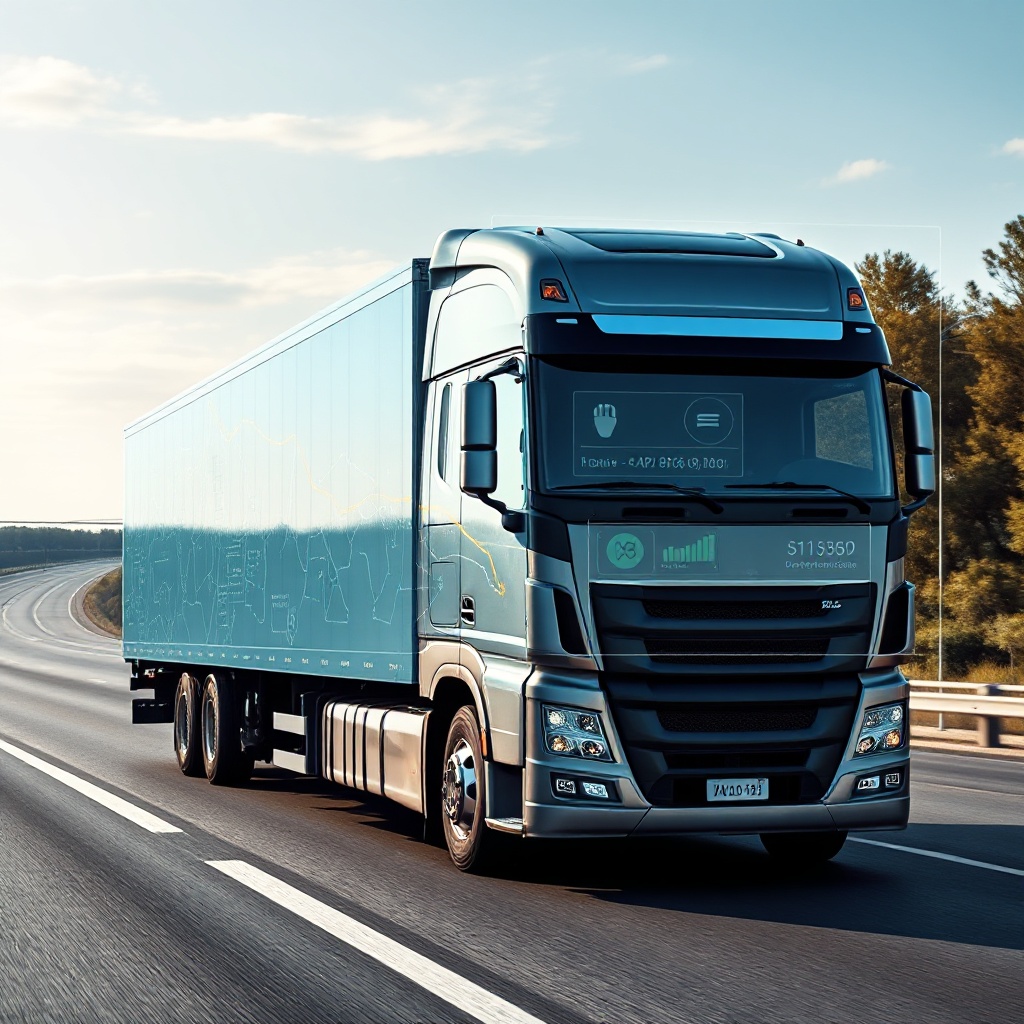
AI revolutionizes freight operations with route optimization, predictive analytics, and telematics, cutting fuel costs and increasing efficiency while meeting sustainability goals.

Drivetech Partners
Artificial intelligence is revolutionizing freight operations in 2025, with cutting-edge solutions for route optimization, predictive analytics, and telematics drastically reducing fuel costs across the logistics industry. From UPS saving millions of gallons annually through AI routing to trucking fleets boosting efficiency with automated load matching, these technologies are delivering measurable improvements in operational efficiency while simultaneously addressing growing environmental pressures.
Key Takeaways
Dynamic route optimization systems like UPS's ORION are saving carriers up to $400 million annually while cutting millions of gallons in fuel consumption
AI-powered predictive analytics platforms are forecasting demand with over 90% accuracy, reducing empty miles and preventing costly breakdowns
Automated freight matching solutions have boosted revenue per truck by up to 17% while increasing load counts by 35% for early adopters
Real-time telematics and driver monitoring are cutting fuel waste from idling, harsh acceleration, and inefficient driving behaviors
Companies implementing integrated AI solutions are achieving 20-30% cost savings while meeting increasing regulatory and consumer demands for sustainability

Revolutionary Route Optimization: How AI is Slashing Fuel Consumption
AI-powered route optimization has emerged as a game-changing technology for freight carriers looking to cut fuel costs and improve efficiency. These sophisticated systems analyze multiple data streams simultaneously—historical traffic patterns, real-time congestion updates, weather forecasts, and delivery volumes—to create dynamically optimized routes that minimize wasted miles.

UPS's ORION (On-Road Integrated Optimization and Navigation) system stands as the gold standard in this space, capable of analyzing over 200,000 routes per minute. The results are impressive: approximately 10 million gallons of fuel saved annually, translating to around $400 million in yearly cost reductions. Beyond the financial benefits, this technology has cut UPS's carbon emissions significantly.
The real power of AI routing lies in its dynamic adaptation capabilities. Unlike traditional static routes, AI systems make continuous adjustments based on changing conditions. This leads to up to 25% fewer late deliveries while maximizing asset utilization across logistics networks. When road closures, traffic incidents, or severe weather appear, the AI recalculates optimal paths instantly, preventing drivers from wasting fuel in congestion or taking unnecessarily long detours.
Predictive Analytics: Forecasting Demand and Preventing Breakdowns
Predictive analytics represents another critical advancement in the freight industry's AI toolkit. By leveraging historical data, seasonal patterns, and macroeconomic indicators, these systems forecast shipment volumes with over 90% accuracy. This precision enables logistics planners to allocate resources efficiently, minimizing both underutilization and costly last-minute scrambles.
C.H. Robinson's Navisphere Vision platform exemplifies the transformative impact of predictive analytics in real-world applications. Clients using this technology have reported 30% improvements in on-time deliveries while cutting logistics costs by an average of 15%. The platform provides risk insights and demand forecasting that help carriers optimize capacity planning and reduce empty miles.
Equally important is the role of predictive maintenance in preventing costly breakdowns. IoT sensors combined with AI algorithms monitor vehicle health in real-time, identifying potential issues before they cause roadside failures. This proactive approach reduces unexpected downtime by 20–30% and generates substantial savings on emergency repairs, which typically cost three to nine times more than planned maintenance.

Smart Load Matching: Automating Freight Allocation for Maximum Efficiency
AI-powered decision automation has transformed load planning and freight matching in 2025. Platforms like Optimal Dynamics now handle up to 80% of load acceptance and allocation decisions for carriers, dramatically reducing the manual effort required while improving outcomes.
The results speak for themselves. Grand Island Express, an early adopter of automated freight matching, increased revenue per truck by more than 17% while boosting overall load count by 35%. Other fleets using similar technology have seen on-time performance improvements from 94% to 96%, a significant gain in an industry where reliability directly impacts customer retention.
Key benefits of these systems include:
Substantial reduction in empty miles
Faster response times to shipper requests
Lower operational expenses
Minimal manual intervention in the planning process
Optimized driver utilization and home time
Real-Time Telematics: Optimizing Driver Behavior for Fuel Savings
The combination of AI, IoT sensors, and real-time telematics has created powerful tools for monitoring and improving driver behavior. These systems track multiple aspects of vehicle operation—from acceleration and braking patterns to idling time and speed consistency—identifying opportunities to reduce fuel consumption through improved driving techniques.
Advanced Driver Assistance Systems (ADAS) provide immediate feedback to drivers, helping them develop more efficient habits. The benefits extend beyond fuel savings to include reduced accident rates, lower insurance premiums, and decreased wear and tear on vehicles.
In 2025, regulatory mandates for telematics and ADAS systems are expanding rapidly as part of green logistics initiatives. These technologies enable:
Real-time driver coaching through AI-generated suggestions
Automated compliance reporting for environmental regulations
Early detection of driving behaviors that waste fuel
Benchmarking against fleet averages to identify improvement opportunities
Green Logistics: Meeting Environmental Regulations and Consumer Demands
AI solutions are proving vital in meeting the dual pressures of tightening environmental regulations and growing consumer demand for sustainable supply chains. By minimizing greenhouse gas emissions through optimized routing, efficient load planning, and improved driver behavior, these technologies directly support sustainability goals.
According to the McKinsey Global Survey, 44% of logistics executives confirmed AI adoption has reduced both costs and emissions, demonstrating the alignment between financial and environmental benefits. Companies deploying comprehensive AI solutions report measurable reductions in total mileage, idle time, and fuel usage—all key metrics for environmental compliance.
For freight carriers, the ability to document these improvements has become increasingly important as customers seek partners with proven sustainability credentials. AI systems provide the detailed tracking and reporting needed to demonstrate environmental performance improvements to both regulators and customers.
Industry Leaders: Case Studies in AI Transformation
Several companies stand out as pioneers in AI adoption for freight operations:
UPS: The ORION system analyzes over 200,000 routes per minute, saving 10 million gallons of fuel and $400 million annually
C.H. Robinson: Their Navisphere Vision platform has improved on-time deliveries by 30% while cutting logistics costs by 15%
Grand Island Express: Using Optimal Dynamics' AI load allocation, they've increased revenue per truck by 17% and load count by 35%
DHL: Implementing AI-powered route optimization and predictive analytics across global operations
Other notable players shaping the future of AI in freight include Beeontrade, Waymo, Tesla, Amazon, and FedEx, each developing specialized applications ranging from autonomous vehicles to robotic last-mile deliveries.
Integration Benefits: Combining AI with Emerging Technologies
The most successful implementations are those that integrate AI systems with other emerging technologies. For example, AI solutions paired with blockchain create enhanced data security, visibility, and operational efficiency throughout the supply chain.
Similarly, the combination of AI with automated warehousing creates end-to-end optimization opportunities that weren't previously possible. Companies implementing these integrated solutions across their operations are achieving 20-30% cost savings compared to traditional approaches.
The integration also enables comprehensive data collection and analysis, creating a virtuous cycle of continuous improvement. As more operational data flows into AI systems, their forecasting and optimization capabilities become increasingly accurate and valuable.
2025 and Beyond: The Future of AI in Freight Logistics
As we move through 2025, AI-driven solutions are rapidly transitioning from competitive advantage to industry standard. Early adopters who have achieved 20–30% cost savings have established significant market advantages, forcing competitors to implement similar technologies to remain viable.
Regulatory and consumer demands for transparency, sustainability, and speed continue to accelerate AI adoption across the logistics sector. Companies that haven't yet embraced these technologies face growing challenges in meeting compliance requirements and customer expectations.
The most forward-thinking organizations are already looking beyond current applications to the next generation of AI solutions: fully autonomous trucks, advanced energy management systems, and comprehensive carbon tracking platforms that will further transform freight operations in the coming years.






